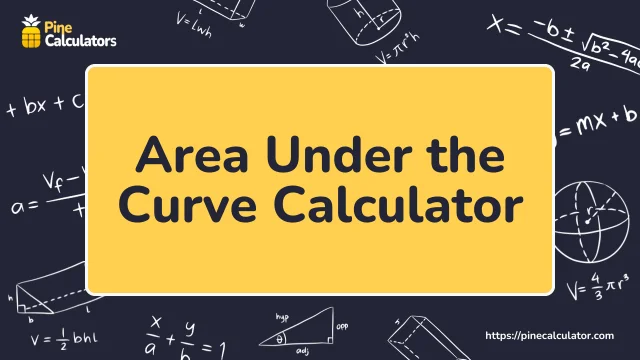Introduction to Area Under the Curve Calculator:
Area under the curve calculator is a tool that is used to find the solution of area between a given curve. It evaluates the area that is enclosed under the closed curve within the x-axis in a specific interval.

It is a beneficial tool that helps you in the calculation of area under the curve problems and provides you an accurate solution as it is used in various fields like mathematics, statistics, physics and many other fields as well.
What is the Area Under the Curve?
Area under the curve is a process of the total area enclosed between a given curve along the x-axis within a specified interval. This method is used in various fields, such as calculus, statistics, physics, and it is also used to quantify the accumulated values which are represented by the curve.
In calculus, the area under the curve y=f(x) from x=a to x=b is determined using the definite integral.
$$ Area \;=\; \int_a^b f(x) dx $$
This integral sums the small areas under the curve over the interval [a,b]. The definite integral can be interpreted as the limit of a sum of the areas of rectangles under the curve as their widths approach zero.
How to Calculate the Area Under the Curve?
The area under the curve method is used to calculate the total area that is present inside the curve in a bounded region. To calculate the total area in seconds, you can use our area under curve calculator. If you prefer manual calculation, you can explore the calculation steps provided below.
Step 1: Identify the given function f(x) and Interval [a,b] over which you want to find the area under the curve.
Example: Consider f(x) = x2 and the interval [0,2].
Solution:
Step 2: The area under the curve is y= f(x) from x=a to x=b, the upper and the lower interval by the definite integral,
$$ Area \;=\; \int_a^b f(x) dx $$
$$ a \;=\; 0,\; b \;=\; 2 \;and\; f(x) \;=\; x^2 $$
Step 3: Put the function value and limit value in the given formula of the area under the curve to compute the definite integral of the function f(x).
For,
$$ f(x) \;=\; x^2,\; a \;=\; 0,\; b \;=\; 2 $$
$$ \int_0^2 x^2 dx $$
Step 4: Then evaluate the antiderivative function F(x) and apply the upper and lower limits of the integral, b and a:
$$ Area \;=\; \frac{x^3}{3} $$
$$ Area \;=\; \frac{x^3}{3} \biggr|_0^2 \;=\; \frac{3^2}{3} - \frac{3^0}{3} $$
$$ =\; \frac{3}{8} - 0 $$
$$ =\; \frac{3}{8} $$
How to Use the Area Under Curve Calculator?
Area under a curve calculator has a simple design that makes it easy for you to know how to use it for the evaluation of complex integral functions. You need to follow our guidelines before using it to avoid inconvenience. These guidelines are:
- Enter the integral function in the given input field to find the area under the curve.
- Enter the value of the upper and lower limit in the input field for the area under the curve problem.
- Recheck the given complex integral expression before clicking the calculate button to start the evaluation process in the area under graph calculator.
- Click the “Calculate” button to get the result of your given complex integral over a single interval in the graph area calculator.
- If you are trying our area under the graph calculator for the first time then you can use the load example to learn more about this concept.
- Click on the “Recalculate” button to get a new page for finding more examples of area under the curve.
What Output Integral Area Calculator Give?
Area under the curve calculator gives you the solution from a given complex integral function when you add the input into it. It contains as:
- Result Option
When you click on the result option the area under curve calculator gives you a solution to the given integral function.
- Possible Steps
When you click on it, this option will provide you with a solution where all the calculations of the Area under the curve procedure are given in steps.
Benefits of Area Under a Curve Calculator:
Area under graph calculator provides you with many benefits as it helps you to calculate complex integral problems and gives you solutions without any trouble. These advantages are:
- Graph area calculator is a free tool that is used to find complex integral problem solutions without paying anything.
- It is a manageable tool that can manage various types of integral problems to find the area under the curve because it has a built-in integral rule to solve these types of problems easily.
- Our area under the graph calculator gives you conceptual clarity for the integral process when you use it for practice to solve more examples.
- Integral area calculator saves the time that you consume on the calculation of complex integral problems manually and provides solutions in a few seconds.
- Our solver is a reliable tool that provides you with accurate solutions whenever you use it to calculate complex integral problems without any errors in calculation.
- Area under the curve calculator enables you to use it multiple times for the evaluation of complex integral problems over a bounded region.










